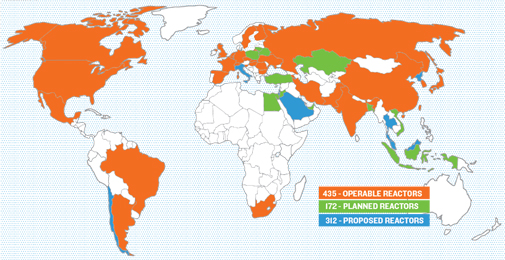There are currently 71 nuclear power reactors under construction in 14 countries around the world, more than 170 are planned with a potential net capacity of 186,663 MWe, and over three hundred additional reactors are proposed.

Sixteen countries depend on nuclear power for at least a quarter of their electricity. France gets around three quarters of its power from nuclear energy, while Belgium, Czech Republic, Hungary, Slovakia, Sweden, Switzerland, Slovenia and Ukraine get one third or more. South Korea, Bulgaria and Finland normally get more than 30% of their power from nuclear energy, while in the USA, UK, Spain and Russia almost one fifth is from nuclear. Japan is used to relying on nuclear power for more than one quarter of its electricity and is expected to return to that level. Among countries which do not host nuclear power plants, Italy and Denmark get almost 10% of their power from nuclear.
Increasing energy demand, concerns over climate change and dependence on overseas supplies of fossil fuels are coinciding to make the case for increasing use of nuclear power.
Countries with established programmes are seeking to replace old reactors as well as expanding existing capacity through plant upgrading, and an additional 45 countries are either considering or have already decided to make nuclear energy part of their power generation mix. However, most (over 80%) of the expansion in this century is likely to be in countries already using nuclear power.
Mainland China has 20 nuclear power reactors in operation, 28 under construction, and more about to start construction. Additional reactors are planned, including some of the world's most advanced, to give a four-fold increase in nuclear capacity to at least 58 GWe by 2020, then possibly 200 GWe by 2030, and 400 GWe by 2050
India has a flourishing and largely indigenous nuclear power program and expects to have 14,600 MWe nuclear capacity on line by 2020. It aims to supply 25% of electricity from nuclear power by 2050.
The UAE accepted a $20 billion bid from a South Korean consortium to build four commercial nuclear power reactors, total 5.6 GWe, by 2020 at Barakah. Construction of the first unit started in July 2012, and the second in May 2013.
Communities in Finland and Sweden have accepted the local construction of permanent disposal sites for nuclear waste.
An important element in this global expansion of nuclear power is that international cooperation and commerce is growing. Major nuclear industry companies span several countries, giving much enhanced international collaboration. At the same time, countries with an established nuclear industry can, through formal international collaboration under the auspices of the IAEA, assist developing countries to gain access to advanced technologies, helping them to address poverty without emissions of greenhouse gases.
|